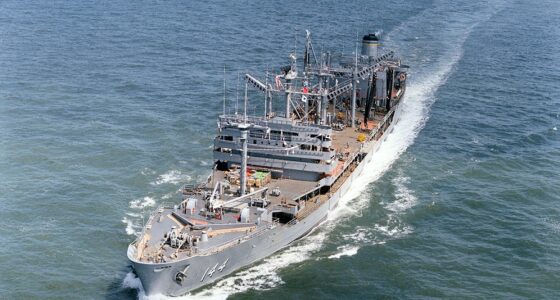The USS Mississinewa (AO-144) was a Navy fleet oiler that provided essential fuel and supply services to allied forces during the Cold War era. Like almost all naval vessels constructed in the post-World War II period, the USS Mississinewa was built with extensive asbestos materials throughout her structure. Veteranswho served aboard the Mississinewa faced significant health risks, with many later developing serious asbestos-related diseases, including mesothelioma, lung cancer, and asbestosis.

About the USS Mississinewa
The USS Mississinewa, designated as fleet oiler AO-144, was the second U.S. Navy vessel to bear the name, which honors a river in Indiana. She was one of six Neosho-class fleet oilers built in the 1950s. One of many types of auxiliary ships that improved naval efficiency, the ships were specifically designed to deliver fuel, provisions, supplies, and mail services to ships that were operating at sea for extended periods.[1]
Measuring 655 feet in length with an 86-foot beam, the Mississinewa displaced 11,600 tons when light and 38,000 tons when full. The ship could accommodate 324 crew members and officers and carried an armament of two 5-inch guns and twelve 3-inch guns. She was capable of achieving speeds up to 20 knots.
The vessel was constructed by the New York Shipbuilding Corporation at its Camden, New Jersey, shipyard. Her keel was laid in May 1953, and she was launched in June 1954, with Mrs. Jerauld Wright, wife of Admiral Jerauld Wright, serving as sponsor. The ship was commissioned in January 1955 under the command of Captain Marvin J. Jensen.
Construction and Service History
Initially, after being commissioned, the Mississinewa largely operated along the Eastern seaboard, with a brief Mediterranean deployment. In May 1956, she was relocated to Naples, Italy, which became her home port. The ship spent nearly a decade in the Mediterranean, supporting the Sixth Fleet.[1]
During her service in the Mediterranean, the Mississinewa played crucial roles in several international crises. In late 1956 and early 1957, she provided logistical support to Sixth Fleet vessels during the Suez Crisis. In July 1958, she quickly moved to support fleet operations during the Lebanese crisis, positioning herself off the Lebanese coast until September and refueling over 200 ships as Marines were deployed at President Camille Chamoun’s request.
From 1962 to 1964, the Mississinewa’s services became even more important as she was assigned to serve as the flagship for the Commander Service Force, Sixth Fleet. This role made her integral to the United States’ dedication to the Sixth Fleet maintaining independence from European land-based facilities.[1]
During regular overhaul periods, the vessel received significant upgrades, including in 1957 when a helicopter landing pad was installed and a helicopter was assigned to the ship to help with vertical replenishment operations. After returning to Newport as her home port in September 1964, she continued operating in the western Atlantic. She was sent to sites ranging from Newfoundland to the Caribbean, as well as on regular Mediterranean deployments and NATO exercises, including operations in northern Norway in August 1966.
The Mississinewa was decommissioned on November 15, 1976, and was then transferred to the Military Sealift Command with the designation T-AO-144. She remained in service until July 1991, when she was placed in the James River Reserve Fleet. After being stricken from the Naval Vessel Register in 1994 and transferred to the Maritime Administration in 1999, she was sold for scrapping in 2006 and broken up at Brownsville, Texas, with the process completed in February 2008.[1]
Asbestos Contamination on Naval Oilers
Though they served an important purpose, fleet oilers and tankers like the Mississinewa were among the most heavily contaminated vessels in the Navy’s fleet. These ships contained thousands of pounds of dangerous asbestos-containing materials that had been supplied by manufacturers and suppliers who knew the health risks they posed. Despite the danger to service members and shipyard workers, these companies prioritized profits over the safety of those using their products; they concealed the dangers from the Navy as well as all others exposed to their materials.
Asbestos was used in multiple applications throughout the Mississinewa’s construction and systems. The carcinogen was used for insulating pipes, boilers, and electrical components, as well as in the construction of the ship’s hull. It served as fire-retardant material in numerous shipboard locations, including deck surfaces and bulkhead walls.
The most hazardous areas aboard oilers and tankers were their fire rooms, pump rooms, and engine compartments, where asbestos insulation covered piping and electrical systems. Personnel working in these spaces faced the highest exposure risks, particularly boiler tenders, electrician’s mates, enginemen, machinist mates, pipefitters, and shipfitters.
Who Was Most at Risk of Asbestos Exposure Onboard the Mississinewa?
There are volumes of research documenting the devastation that exposure to asbestos causes, but there are also specific risks faced by those serving on oil tankers. A comprehensive Norwegian study followed 1,687 captains and mates from 1970 to 1987. It revealed dramatically increased malignancy rates among tanker crew members, with those working on oil tankers showing an odds ratio of 6.47 for developing lung cancer. The study found that mates faced particularly high risks (OR = 6.95) compared to captains (OR = 1.42), likely due to their greater exposure to hazardous materials during routine operations.[2]
It’s unlikely that any personnel serving on the USS Mississinewa were able to avoid asbestos exposure. The material was present in almost every aspect of the ship, and was spread through the ventilation system and carried throughout the vessel on crew members’ hair, skin, and clothing. Still, certain crew members were at higher risk than others because of their duties and work locations. Maintenance and repair personnel faced particularly dangerous conditions, as their work disturbed asbestos-containing materials and released deadly fibers into the ship’s confined spaces.
The case of the late William Losurdo illustrates the typical exposure patterns experienced by USS Mississinewa veterans. Mr. Losurdo served aboard the vessel from 1969 to 1970, initially performing deck maintenance duties before advancing to administrative responsibilities. When the ship underwent repairs at Boston Naval Shipyard in March 1970, his job required him to enter the engine room and spend 30 to 60 minutes in areas where equipment was being cut and drilled, three to four times weekly.[3]
Before his death, Mr. Losurdo testified that he recalled seeing “particles flying around” and the dust that was constantly present due to ongoing repair work on machinery. Even if his work hadn’t required that he visit the most contaminated spots in the ship, his office was located just a few feet from the entrance to the engine room, so he was continuously exposed to airborne asbestos fibers. Pleural mesothelioma claimed Mr. Losurdo’s life, and his family is currently pursuing legal action against General Electric, which provided the ship’s main propulsion turbines, and Westinghouse, which provided three of the ship’s turbine service generators.[3]
Compensation and Legal Options for Veterans
Many Navy veterans who served aboard the USS Mississinewa developed asbestos-related illnesses as a result of the negligence of the asbestos manufacturers and suppliers. They have multiple avenues for pursuing compensation and justice from those who are responsible, ranging from filing claims with the Department of Veterans Affairs for medical care and disability compensation to filing a personal injury lawsuit.
VA Claims
The Department of Veterans Affairs provides disability benefits for service-connected illnesses, and asbestos diseases have been recognized as common maladies among those who served in the Navy. Though several diseases qualify for benefits, mesothelioma generally receives a 100% disability rating due to its devastating nature.
Asbestos Trust Funds
Many of the companies that knew of asbestos’s dangers but continued supplying these materials to the Navy have been forced into bankruptcy as a result of overwhelming asbestos claims. As part of their reorganization agreements, they were required to establish trust funds specifically to compensate affected veterans who would be diagnosed in future years. These trust funds currently hold over $30 billion in reserve for payment to asbestos victims, and the process for obtaining compensation is quick and relatively stress-free.
Lawsuits and Settlements
Veterans and their families can also pursue legal action against the manufacturers of asbestos-containing equipment and materials used aboard naval vessels, seeking compensation for the damages they’ve suffered as a result of the companies’ negligence. Experienced mesothelioma attorneys can help veterans navigate the complex process of identifying responsible parties, filing VA benefit claims, and pursuing lawsuits or trust fund claims.
If you served aboard the USS Mississinewa or other naval vessels and have been diagnosed with mesothelioma, lung cancer, asbestosis, or other asbestos-related diseases, legal and financial help is available. Consulting with specialized mesothelioma lawyers can help ensure you receive the compensation you deserve for your service-connected illness.
References
- Naval History and Heritage Command. (N.D.). USS Mississinewa (AO-144)
Retrieved from: https://www.history.navy.mil/research/histories/ship-histories/danfs/m/mississinewa-ao-144-ii.html - Wiley Online Library. (January 1990.). Cancer among captains and mates on Norwegian tankers # USS Mississinewa and Asbestos
Retrieved from: https://onlinelibrary.wiley.com/doi/10.1111/j.1699-0463.1990.tb01020.x - Justia. (March 31, 2025.). LOSURDO et al v. VIACOMCBS INC. et al
Retrieved from: https://docs.justia.com/cases/federal/district-courts/new-jersey/njdce/2:2021cv01965/460097/204

Terri Heimann Oppenheimer
WriterTerri Oppenheimer has been writing about mesothelioma and asbestos topics for over ten years. She has a degree in English from the College of William and Mary. Terri’s experience as the head writer of our Mesothelioma.net news blog gives her a wealth of knowledge which she brings to all Mesothelioma.net articles she authors.

Dave Foster
Page EditorDave has been a mesothelioma Patient Advocate for over 10 years. He consistently attends all major national and international mesothelioma meetings. In doing so, he is able to stay on top of the latest treatments, clinical trials, and research results. He also personally meets with mesothelioma patients and their families and connects them with the best medical specialists and legal representatives available.


